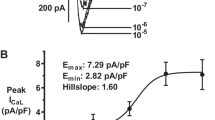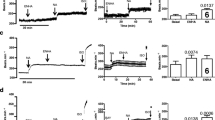Abstract
Evidence from ventricular preparations of cat, sheep, rat and dog suggests that both β1-adrenoceptors (β1AR) and β2-adrenoceptors (β2AR) mediate positive inotropic effects but that only β1AR do it through activation of a cAMP pathway. On the other hand, our evidence has shown that both β1 AR and β2 AR hasten relaxation of isolated human myocardium consistent with a common cAMP pathway. We have now investigated in the isolated human right atrial appendage, a tissue whose β-AR comprise around 2/3 of β1AR and 1/3 of β2AR, whether or not β2AR-mediated effects occur via activation of a cAMP pathway. We carried out experiments on atria obtained from patients without advanced heart failure undergoing open heart surgery. To activate β2AR, we used the β2AR-selective ligand zinterol. Experiments were carried out on paced atrial strips (1 Hz) and tissue homogenates and membrane particles. Zinterol caused positive inotropic and lusitropic (i.e. reduction of t1:2 of relaxation) effects with EC50 values of 3 and 2 nM, respectively. The zinterol-evoked effects were unaffected by the β AR-selective antagonist CGP 20712A (300 nM) but blocked surmountably by the β2AR-selective antagonist ICI 118551 (50 nM) which reduced both EC50 values to 1 μM. Zinterol stimulated adenylyl cyclase activity with an EC50 of 30 nM and intrinsic activity of 0.75 with respect to (−)-isoprenaline (600 μM); the effects were resistant to blockade by CGP 20712A (300 nM) but antagonised surmountably by ICI 118551 (50 nM). Zinterol bound to membrane PAR labelled with (−)-[125I] cyanopindolol with higher affinity for β2AR than for β- 1 AR; the binding to β2AR but not to β- BAR was reduced by GTPyS (10 μM). In the presence of CGP 20712A (300 nM) (−)-isoprenaline (400 μM); (to activate both β1AR and β2AR maximally) and zinterol (10 μM); increased contractile force 3.4-fold and 2.5-fold respectively and reduced relaxation tut by 32% and 18% respectively. These effects of (−)-isoprenaline and zinterol were associated (5 min incubation) with phosphorylation (pmol P/mg supernatant protein) of troponin I and C-protein to values of 8.4 ± 2.0 vs 12.4 ± 2.3 and 10.1 ± 2.5 vs 8.6 ± 1.6 respectively. (−)-Isoprenaline and zinterol also caused phosphorylation of phospholamban (1.8 ± 0.3 vs 0.4 ± 0.1 pmol P/mg respectively) specifically at serine residues. We conclude that in human atrial myocardium activation of both β1AR and β2AR leads to cAMP-dependent phosphorylation of proteins involved in augmenting both contractility and relaxation.
Similar content being viewed by others
References
Kaumann AJ, Hall JA, Murray KJ, Wells FC, Brown MJ: A comparison of the effects of adrenaline and noradrenaline on human hearts: the role of β1- and β2-adrenoceptors in the stimulation of adenylate cyclase and contractile force. Eur Heart J 10 (Suppl B): 29–37, 1989
Buxton BF, Jones CR, Molenaar P, Summers RJ: Characterization and radioautographic localization of β-adrenoceptor subtypes in human cardiac tissues. Br J Pharmacol 92: 299–310, 1987
Kaumann AJ, Lynham JA, Sanders L, Brown AM, Molenaar P: Contribution of differential efficacy to the pharmacology of human β1 — and β2-adrenoceptors. Pharmacol Commun 6: 215–222, 1995
Gille E, Lemoine H, Ehle B, Kaumann AJ: The affinity of (−)-propranolol for β1- and β2-adrenoceptors of human heart. Differential antagonism of the positive inotropic effects and adenylate cyclase stimulation by (−)-noradrenaline and (−)-adrenaline. NaunynSchmiedeberg's Arch Pharmacol 331: 60–70, 1985
Kaumann AJ, Lemoine H: β2-adrenoceptor-mediated positive inotropic effects of adrenaline in human ventricular myocardium. Quantitative discrepancies between binding and adenylate cyclase stimulation. Naunyn-Schmiedeberg's Arch Pharmacol 335: 403–411, 1987
Kaumann AJ: Adrenaline and noradrenaline increase contractile force of human ventricle through both β1- and β2-adrenoceptors. Biomed Biochem Acta 46: S 411-S 416, 1987
Bristow MR, Hershberger RE, Port JD, Minobe W, Rasmussen R: β1 — and β2-adrenergic receptor-mediated adenylate cyclase stimulation in nonfailing and failing human ventricular myocardium. Mol Pharmacol 35:295–303, 1989
Green SA, Holt BD, Liggett SB: β1- and β2-adrenergic receptors display subtype-selective coupling to Gs. Mol Pharmacol 41: 889–893, 1992
Levy FO, Zhu X, Kaumann AJ, Birnbaumer L: Efficacy of β1-adrenergic receptors is lower than that of β2 adrenergic receptors. Proc Natl Acad Sci USA 90: 10798–10802, 1993
Hall JA, Kaumann AJ, Brown MJ Selective β1-adrenoceptor blockade enhances positive inotropic effects of endogenous catecholamines through β2-adrenoceptors in human atrium. Circ Res 66: 1610–1623, 1990
Lemoine H, Kaumann AJ: Regional differences of β1- and β2-adrenoceptor-mediated functions in feline heart. A β2-adrenoceptor-mediated positive inotropic effect possibly unrelated to cyclic AMP. Naunyn-Schmiedeberg's Arch Pharmacol 344: 56–69, 1991
Reuter H: Calcium channel modulation by neurotransmitters, enzymes and drugs. Nature 301: 569–574, 1983
Katz AM: Interplay between inotropic and lusitropic effects of cyclic adenosine monophosphate on the myocardial cell. Circulation 82; (suppl 1): I-7-I-11, 1990
Kaumann AJ, Lemoine H, Schwederski-Menke U, Ehle B: Relations between β- adrenoceptor occupancy and increases of contractile force and adenylate cyclase activity induced by catecholamines in human ventricular myocardium. Acute desensitization and comparison with feline ventricle. Naunyn-Schmiedeberg's Arch Pharmacol 339: 99–112, 1989
Borea PA, Amerini S, Masini I, Cerbai E, Ledda F, Mantelli L, Varani K, Mugelli A: β1- and β2-adrenoceptors in sheep cardiac ventricular muscle. J Mol Cell Cardiol 24: 753–764, 1992
Xiao RP, Lakatta EG: β1-Adrenoceptor stimulation and β2-adrenoceptor stimulation differ in their effects on contraction,cytosolic Ca2+, and Cat. current in single rat ventricular cells. Circ Res 73: 286–300, 1993
Xiao RP, Hohl C, Altschuld R, Jones LR, Livington B, Ziman B, Tantini B, Lakatta EG: β2-Adrenergic receptor-stimulated increase in cAMP in rat heart cells is not coupled to changes in Ca2+ dynamics, contractility, or phospholamban phosphorylation. J Biol Chem 269: 1–6, 1994
Xiao RP, Xiangwu J, Lakatta EG: Functional coupling of the β2 adrenoceptor to a pertussis toxin-sensitive G protein in cardiac myocytes. Mol Pharmacol 47: 322–329, 1995
Altschuld R, Starling RC, Hamlin RL, Billman GE, Hensley J, Castillo L, Fertel RH, Hohl CM, Robitaille P-ML, Jones L, Xiao RP, Lakatta EG: Response of failing canine and human heart cells to β2- adrenergic stimulation. Circulation 92: 1612–1618, 1995
Gwee MCE, Non MW, Raper C, Rodger IW: Pharmacological actions of a new β-adrenoceptor agonist MJ-9184- I, in anaesthetized cats. Br J Pharmacol 46: 375–385, 1972
Minneman KP, Hegstrand LR, Molinoff PB: The pharmacological specificity of beta-1 and beta-2 adrenergic receptors in rat heart and lung in vivo. Mol Pharmacol 16: 21–33, 1979
Brodde O-E, Karad K, Zerkowski H-R, Rohm N, Reidemeister JC: Coexistence of β1- and β2 adrenoceptors in human right atrium. Direct identification by (±)-[125I] iodocyanopindolol. Circ Res 53: 752–758, 1983
Bristow MR, Hershberger RE, Port JD, Gilbert EM, Sandoval A, Rasmussen R, Cates AE, Feldman AM: β-Adrenergic pathways in nonfailing and failing human ventricular myocardium. Circulation 82 (suppl 1) I-12-I-25, 1990
Brodde O-E, O'Hara N, Zerkowski H-R, Rohm N: Human cardiac β-adrenoceptors: both β1- and β2-adrenoceptors are functionally coupled to adenylate cyclase in right atrium. J Cardiovasc Pharmacol 6: 1184–1191, 1984
Dooley DJ, Bittiger H, Reymann NC: CGP 20712A; a useful tool for quantifying β1- and β2-adrenoceptors. Eur J Pharmacol 130: 137–140, 1986
Kaumann AJ, Birnbaumer L: Characteristics of the adrenergic receptor coupled to myocardial adenylyl cyclase: stereospecificity for ligands and determination of apparent affinity constants for β- blockers. J Biol Chem 249: 7874–7885, 1974
Salomon Y, Londos C, Rodbell M: A highly sensitive adenylate cyclase assay. Anal Biochem 58: 541–548, 1974
Bradford M: A rapid and sensitive method for the quantitation of microgram quantities of protein utilizing the principle of protein-dye binding. Anal Biochem 72: 248–254, 1976
Karczewski P, Bartel S, Krause E-G: Differential sensitivity to isoproterenol of troponin I and phospholamban phosphorylation in isolated rat heart. Biochem J 266: 115–122, 1990
Lowry OH, Rosebrough NJ, Farr AL, Randall RJ: Protein measurement with folin phenol reagent. J Biol Chem 193: 265–275, 1951
Drago, GA, Colyer J: Discrimination between two sites of phosphorylation on adjacent amino acids by phosphorylation site-specific antibodies to phospholamban. J Biol Chem 269: 25073–25077, 1994
Wegener AD, Simmerman HKB, Lindemann JP, Jones LR: Phospholamban phosphorylation in intact ventricles. Phosphorylation of serine 16 and threonine 17 in response to beta-adrenergic stimulation. J Biol Chem 264: 11468–11474, 1989
Karczewski P, Bartel S, Haase H, Krause E-G: Isoproterenol induces both CAMP-and calcium-dependent phosphorylation of phospholamban in canine heart in vivo. Biomed Biochem Acta 46: 433–439, 1987
Colyer J, Wang JH: Dependence of cardiac sarcoplasmic reticulum pump activity on the phosphorylation status of phospholamban. J Biol Chem 255:17486–17493, 1991
Xu A, Hawkins C, Narayanan N: Phosphorylation and activation of the Ca2+/calmodulin-dependent protein kinase. J Biol Chem 268: 8394–8397, 1993
Talosi L, Edes I, Kranias EG: Intracellular mechanisms mediating reversal of beta-adrenergic stimulation in intact beating hearts. Am J Physiol 264: H791-H797, 1993
Karczewski P, Kuschel M, Baltas LG, Bartel S, Krause EG: Site-specific phosphorylation of a phospholamban peptide by cyclic nucleotide-and Ca 2+/calmodulin-dependent protein kinases of cardiac sarcoplasmic reticulum. Basic Res Cardiol (in press), 1996
Bartel S, Stein B, Eschenhagen T, Mende U, Neumann J, Schmitz W, Krause EAG, Karczewski P, Scholz H: Protein phosphorylation in isolated trabeculae from nonfailing and failing human heart. Mol Cell Biochem (in press), 1996
Koss KL, Ponniah S, Jones WK, Grupp IL, Kranias EG: Differential phospholamban gene expression in murine cardiac compartments. Circ Res 77: 342–353, 1995
Kranias EG: Regulation of Ca2+ transport by phosphoprotein phosphatase activity associated with sarcoplasmic reticulum. J Biol Chem 260:11006–11010, 1985
Garvey JL, Kranias EG, Solaro RJ: Phosphorylation of C-protein, troponin I and phospholamban in isolated rabbit hearts. Biochem J 249:709–714, 1988
Herzig JW, Riiegg JC: Investigations on glycerinated cardiac muscle fibres in relation to the problem of regulation of cardiac contractility — effects of Ca2+ and CAMP. Basic Res Cardiol 75: 26–33, 1980
Feldman AM, Ray PE, Silan CM, Mercer JA, Minrobe W. Bristow MR: Selective gene expression in failing human heart. Circulation 83:1866–1872, 1993
Arai M, Alpert NR, MacLennan DH, Barton P, Periasamy M: Alterations in sarcoplasmic reticulum gene expression in human heart failure: a possible mechanism for alterations in systolic and diastolic properties of the failing myocardium. Circ Res. 72: 463–469, 1993
Movsesian MA, Karimi M, Green K, Jones LR: Ca2+ transporting ATPase, phospholamban, and calsequestrin levels in nonfailing and failing human heart. Circulation 90: 653–657, 1994
Schwinger RHG, Böhm M, Schmidt U, Karczewski P, Bavendiek U, Flesch M, Krause EAG, Erdmann E: Unchanged protein levels of SERCAII and phospholamban but reduced Ca2+ uptake and Ca2+ ATPase activity of cardiac sarcoplasmic reticulum from patients with dilated cardiomyopathy compared to nonfailing patients. Circulation 92:3220–3228, 1995
Feldman AM, Cates AE, Veazey WB, Hershberger RE, Bristow MR, Baughman KL, Baumgartner WA, van Dop C: Increase in the 40,000mol wt pertussis toxin substrate (G-protein) in the failing human heart. J Clin Invest 82: 189–197, 1988
Eschenhagen, T: G proteins and the heart. Cell Biol Int 17: 723–749, 1993
Kaumann AJ, Sanders L: Both β1- and β2-adrenoceptors mediate catecholamine- evoked arrhythmias in isolated human right atrium. Naunyn-Schmiedeberg's Arch Pharmacol 348: 536–540, 1993
Kaumann AJ, Sanders L, Hall JA, Murray KJ, Brown MJ: Stimulation of β1- and β2-adrenoceptors in human ventricular myocardium from failing hearts hastens the onset of relaxation. Br J Pharmacol 105: 283 P, 1992
DelMonte F, Kaumann AJ, Poole-Wilson PA, Wynne DG, Pepper J, Harding SE: Coexistence of functional β1- and β2 adrenoceptors in single myocytes from human ventricle. Circulation 88: 889–893, 1993
Author information
Authors and Affiliations
Rights and permissions
About this article
Cite this article
Kaumann, A.J., Sanders, L., Lynham, J.A. et al. β2-Adrenoceptor activation by zinterol causes protein phosphorylation, contractile effects and relaxant effects through a cAMP pathway in human atrium. Mol Cell Biochem 163, 113–123 (1996). https://doi.org/10.1007/BF00408647
Issue Date:
DOI: https://doi.org/10.1007/BF00408647




